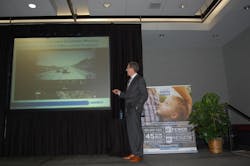LOUISVILLE. Jon Morrison, WABCO’s president for the Americas, believes that autonomous trucks won’t become a “true” reality until there is more widespread adoption of the various advanced safety technologies now already in the marketplace that will give commercial vehicles the ability to drive themselves on U.S. roads.
“Automation is certainly a fantastic vision but don’t forget the technologies needed to make it work are available today and need to be more accepted by the industry,” he explained to Fleet Owner in an interview here at the 2016 Mid America Trucking Show.
He noted that safety systems such as full stability control is only spec’d on 35% of today’s Class 8 builds, with collision mitigation technology only spec’d on 15% of them.
The same goes for air disc brakes (ADBs), which Morrison considers to be the “bedrock platform” upon which full-autonomous trucks will rest upon.
Right now, ADBs are spec’d on only 15% of U.S. Class 8 trucks today, with a little less than that percentage spec’d on trailers – up significantly from 5% just five years ago but still growing very slowly. He believes that will only increase to 20% over the next two to three years.That’s why, from his perspective, a “tremendous amount of evolution” in terms of better integration and lower cost needs to be achieved first with the “disparate technological pieces” that will guide autonomous trucks.
That being said, Morrison (at right) thinks at least “semi-autonomous” trucks – ones capable of actively controlling themselves in emergency situations – should arrive sometime in the mid 2020s.
One reason he maintains that confidence is the increased in safety system integration, which is helping lower the cost of such technology, using the integration of his company’s OnLane lane departure warning system (LDWS) with the SmartDrive video-based driver performance management system.
Combining the two eliminates the need for two forward-looking cameras previously required to provide the same functionality as the new OnLane package and represents the first product integration arising from WABCO’s strategic partnership with SmartDrive, which included a $20 million investment in that firm as well.
“ROI (return on investment) for such systems is very critical for fleets, but it also depends on the fleet’s particular experience,” Morrison noted. “We try to keep ROI between 18 and 24 months; that’s the threshold for fleet’s who own their trucks for three to five years. That’s why efforts to continually reduce cost – like eliminating that second camera from the OnLane/SmartDrive package – remain so critical.”
About the Author
Sean Kilcarr
Editor in Chief
Sean Kilcarr is a former longtime FleetOwner senior editor who wrote for the publication from 2000 to 2018. He served as editor-in-chief from 2017 to 2018.

